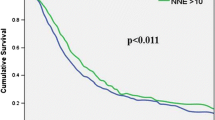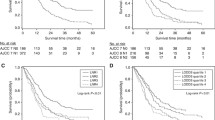Abstract
Background
Based on data from other malignancies, the number of lymph nodes evaluated and the ratio of metastatic to examined lymph nodes (LNR) may be important predictors of survival. LNR has never been investigated in a large population-based study of patients with pancreatic adenocarcinoma.
Methods
The Surveillance, Epidemiology, and End Results (SEER) database was used to identify 4005 patients who underwent resection for pancreatic adenocarcinoma from 1988 to 2003. The effect of total lymph node count and LNR on survival was examined using univariate and multivariate analyses.
Results
The median number of lymph nodes examined was seven; 390 (10.1%) patients had no lymph nodes examined. Of those patients who had at least one lymph node examined, 1507 (43.3%) had no lymph node metastases (N0) and 1971 (56.7%) had metastatic nodal disease (N1). Overall median survival was 13 months, and 5-year survival was 6.8%. N1 disease was associated with a worse 5-year survival compared with N0 disease (4.3 vs 11.3%, respectively, P < .001). Patients with N0 disease could be further stratified based on the number of lymph nodes evaluated (median survival: 1–11 nodes, 16 months vs 12 or more nodes, 23 months; P < .001). For N1 patients, LNR was one of the most powerful factors associated with survival (LNR > 0–0.2, 15 months; LNR > 0.2–0.4, 12 months; LNR > 0.4, 10 months) (P < .001).
Conclusions
Most patients have an inadequate number of lymph nodes evaluated following pancreatic surgery. N0 patients who have fewer than 12 lymph nodes examined may be understaged. In patients with N1 disease, LNR may better substratify patients with regard to prognosis.







Similar content being viewed by others
References
Greene FL. TNM staging for malignancies of the digestive tract: (2003) changes and beyond. Semin Surg Oncol 2003; 21(1):23–9
Han SS, Jang JY, Kim SW, et al. Analysis of long-term survivors after surgical resection for pancreatic cancer. Pancreas 2006; 32(3):271–5
Makary MA, Winter JM, Cameron JL, et al. Pancreaticoduodenectomy in the very elderly. J Gastrointest Surg 2006; 10(3):347–56
Kuhlmann KF, de Castro SM, Wesseling JG, et al. Surgical treatment of pancreatic adenocarcinoma; actual survival and prognostic factors in 343 patients. Eur J Cancer 2004; 40(4):549–58
Reber HA. Lymph node involvement as a prognostic factor in pancreatic cancer. Int J Pancreatol 1990; 7(1–3):125–7
Breslin TM, Hess KR, Harbison DB, et al. Neoadjuvant chemoradiotherapy for adenocarcinoma of the pancreas: treatment variables and survival duration. Ann Surg Oncol 2001; 8(2):123–32
Benassai G, Mastrorilli M, Mosella F, Mosella G. Significance of lymph node metastases in the surgical management of pancreatic head carcinoma. J Exp Clin Cancer Res 1999; 18(1):23–8
Gebhardt C, Meyer W, Reichel M, Wunsch PH. Prognostic factors in the operative treatment of ductal pancreatic carcinoma. Langenbecks Arch Surg 2000; 385(1):14–20
Lim JE, Chien MW, Earle CC. Prognostic factors following curative resection for pancreatic adenocarcinoma: a population-based, linked database analysis of 396 patients. Ann Surg 2003; 237(1):74–85
Sohn TA, Yeo CJ, Cameron JL, et al. Resected adenocarcinoma of the pancreas-616 patients: results, outcomes, and prognostic indicators. J Gastrointest Surg 2000; 4(6):567–79
Pawlik TM, Abdalla EK, Barnett CC, et al. Feasibility of a randomized trial of extended lymphadenectomy for pancreatic cancer. Arch Surg 2005; 140(6):584–9; discussion 589–91
Yeo CJ, Cameron JL, Sohn TA, et al. Six hundred fifty consecutive pancreaticoduodenectomies in the 1990s: pathology, complications, and outcomes. Ann Surg 1997; 226(3):248–7; discussion 257–60
Le Voyer TE, Sigurdson ER, Hanlon AL, et al. Colon cancer survival is associated with increasing number of lymph nodes analyzed: a secondary survey of intergroup trial INT-0089. J Clin Oncol 2003; 21(15):2912–9
Tepper JE, O’Connell MJ, Niedzwiecki D, et al. Impact of number of nodes retrieved on outcome in patients with rectal cancer. J Clin Oncol 2001; 19(1):157–63
Berger AC, Sigurdson ER, LeVoyer T, et al. Colon cancer survival is associated with decreasing ratio of metastatic to examined lymph nodes. J Clin Oncol 2005; 23(34):8706–12
Inoue K, Nakane Y, Iiyama H, et al. The superiority of ratio-based lymph node staging in gastric carcinoma. Ann Surg Oncol 2002; 9(1):27–34
Bando E, Yonemura Y, Taniguchi K, et al. Outcome of ratio of lymph node metastasis in gastric carcinoma. Ann Surg Oncol 2002; 9(8):775–84
Ichikura T, Ogawa T, Chochi K, et al. Minimum number of lymph nodes that should be examined for the International Union Against Cancer/American Joint Committee on Cancer TNM classification of gastric carcinoma. World J Surg 2003; 27(3):330–3
Berger AC, Watson JC, Ross EA, Hoffman JP. The metastatic/examined lymph node ratio is an important prognostic factor after pancreaticoduodenectomy for pancreatic adenocarcinoma. Am Surg 2004; 70(3):235–40; discussion 240
Sierzega M, Popiela T, Kulig J, Nowak K. The ratio of metastatic/resected lymph nodes is an independent prognostic factor in patients with node-positive pancreatic head cancer. Pancreas 2006; 33(3):240–5
Pawlik TM GA, Cameron JL, Winter JM, et al. Prognostic Relevance of Lymph Node Ratio Following Pancreaticoduodenectomy for Pancreatic Cancer. Surgery 2007; 141(5):610–8
Hartel M, Wente MN, Di Sebastiano P, et al. The role of extended resection in pancreatic adenocarcinoma: is there good evidence-based justification? Pancreatology 2004; 4(6):561–6
Zippin C, Lum D, Hankey BF. Completeness of hospital cancer case reporting from the SEER Program of the National Cancer Institute. Cancer 1995; 76(11):2343–50
Stata Statistical Software: Release 9.2 (computer program). College Station, TX: StataCorp LP 2005
Smith DD, Schwarz RR, Schwarz RE. Impact of total lymph node count on staging and survival after gastrectomy for gastric cancer: data from a large US-population database. J Clin Oncol 2005; 23(28):7114–24
Ludwig MS, Goodman M, Miller DL, Johnstone PA. Postoperative survival and the number of lymph nodes sampled during resection of node-negative non-small cell lung cancer. Chest 2005; 128(3):1545–50
Liu KJ, Loewen M, Atten MJ, et al. The survival of stage III gastric cancer patients is affected by the number of lymph nodes removed. Surgery 2003; 134(4):639–44; discussion 644–6
Konety BR, Joslyn SA, O’Donnell MA. Extent of pelvic lymphadenectomy and its impact on outcome in patients diagnosed with bladder cancer: analysis of data from the Surveillance, Epidemiology and End Results Program data base. J Urol 2003; 169(3):946–50
Agrama MT, Reiter D, Cunnane MF, et al. Nodal yield in neck dissection and the likelihood of metastases. Otolaryngol Head Neck Surg 2003; 128(2):185–90
Bouvier AM, Haas O, Piard F, et al. How many nodes must be examined to accurately stage gastric carcinomas? Results from a population based study. Cancer 2002; 94(11):2862–6
Wisnivesky JP, Henschke C, McGinn T, Iannuzzi MC. Prognosis of Stage II non-small cell lung cancer according to tumor and nodal status at diagnosis. Lung Cancer 2005; 49(2):181–6
Swanson RS, Compton CC, Stewart AK, Bland KI. The prognosis of T3N0 colon cancer is dependent on the number of lymph nodes examined. Ann Surg Oncol 2003; 10(1):65–71
Schwarz RE, Smith DD. Extent of lymph node retrieval and pancreatic cancer survival: information from a large US population database. Ann Surg Oncol 2006; 13(9):1189–200
Herr HW. Superiority of ratio based lymph node staging for bladder cancer. J Urol 2003; 169(3):943–5
Thorn CC, Woodcock NP, Scott N, et al. What factors affect lymph node yield in surgery for rectal cancer? Colorectal Dis 2004; 6(5):356–61
Author information
Authors and Affiliations
Corresponding author
Rights and permissions
About this article
Cite this article
Slidell, M.B., Chang, D.C., Cameron, J.L. et al. Impact of Total Lymph Node Count and Lymph Node Ratio on Staging and Survival after Pancreatectomy for Pancreatic Adenocarcinoma: A Large, Population-Based Analysis. Ann Surg Oncol 15, 165–174 (2008). https://doi.org/10.1245/s10434-007-9587-1
Received:
Revised:
Accepted:
Published:
Issue Date:
DOI: https://doi.org/10.1245/s10434-007-9587-1




